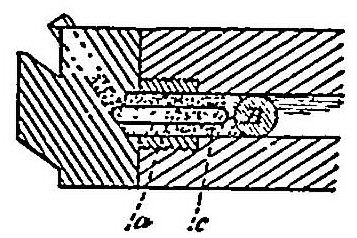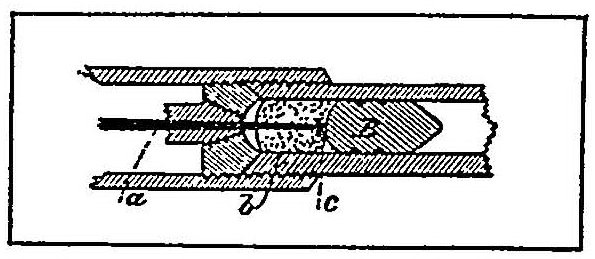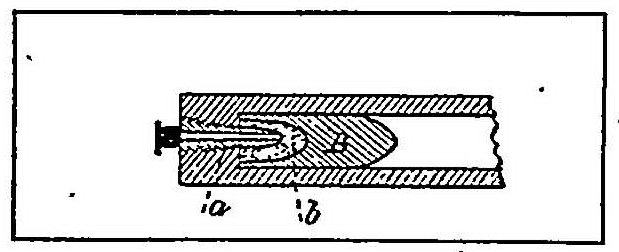
Case No. 5,963.
In re HALSEY.
[1 MacA. Pat. Cas. 459.]
Circuit Court, District of Columbia.
June, 1856.
PATENTABLE INVENTION—IGNITING CHARGE IN FIRE-ARMS—COMBINATION.
[1. Placing a priming tube running forward in the center of a gunbarrel, so asto conduct the 293flash from the cap to the forward end of the powder charge, involves patentable invention, although a similar tube had been previously used to cause ignition in the center of a charge placed in a conical cavity at the rear ofthe ball, and although ignition at the front of the charge had been obtained by means of a needle operating upon a fulminate placed against the rear of the ball.]
[2. Where the invention is of a combination, it is no objection to the patent that the machine, or any parts of it, were previously in use, unlessthe combination itself has existed before. Moody v. Fiske, Case No. 9,745, approved.]
Appeal [by James B. Halsey] from the decision of the commissioner of patents rejecting his application for a patent for a new and useful improvement in igniting the charge in fire-arms.

The applicant's invention will be readily understood from the subjoinedcut taken from the patent subsequently issued to him in accordance with this decision, No. 15,292, July 8th, 1856; a represents the priming-tube for conducting the flash of the cap to the forward part of the charge c, and sofiring the same at that point and just behind the ball B.

In the Prussian needle-gun, cited as reference, of which an illustration istaken from patent to Polnice, No. 11,835, October, 1854, the charge is fired at the same point, but by different devices. A needle a passes through the charge b, and explodes a fulminate c placed against the rear end of the bullet B.

The patent to Swyney, 13,474, August 21st, 1855, shows a priming-tube a like applicant's, which fires the charge b placed in an excavation in the rear end of the bullet B, ator near its middle part.
Everett & Pollok, for appellants.
MORSELL, Circuit Judge. The commissioner's decision is dated the 20th of October, 1855, in which he states: “The references would seenr to present a clear anticipation of the invention; for while the tube of Leroy and Mathiew has perforations throughout its length, it also has one in the end near to or next to the ball, which would communicate fire from the cap to the forward end of the charge of powder; and Swyney's tube is perforated only at the end, though not designed to extend to the forward end of the charge of powder. It is alleged that communicating fire to the forward end of the charge of powder only, produces a different effect from either of the references, and that, therefore, the mode of communicating the fire is patentable, and that the particular device is not deprived of patentable novelty by the device in the Prussian needle-gun for exploding a fulminate at the forward end of the charge of powder. It is true that the devices in the needle-gun and the application are different; but it is not seen clearly that all the advantages of firing the charge at the forward end are hot strictly as marked in the needle-gun as the application, or at least that these advantages are not common to both. The effect, therefore, from the invention is not the point on which whatever of patentability it presents must rest; but besides this, the invention is defective from an uncertainty, depending not onlyon the invention, but the varying volumes of gunpowder in proportion to strength; and this uncertainty reduces the invention simply tothe question of degree in its relation to Swyney's patent;that is to say, if for any purpose or from any cause a larger volume of powder or bulk of charge were used with the applicant's tube, it would not communicatethe fire to the forward end of thecharge, and of course the patent would be inoperative; and if for like reasons, or the use of a cylindrical ball inSwyney's gun, a varying volume of powder were used, the charge might be brought to the level of the end of the tube, and make it communicate thefire exactly to the forward end of the charge.”
The appellant assigns as his reasons of appeal—First. Because, on examination of the allegedinvention or discovery, it did not appear that the same improvement in igniting fire-arms had been invented or discovered by any other person in this country prior to the invention or discoverythereofby the applicant, the said James E. Halsey, or that it had been patented ordescribed in anyprinted publication in this or any foreign country, or hadbeen in public use or on sale with theapplicant's consent and allowance prior to his application, or that an improvement such as this in fire-arms is not sufficiently useful and important to be worthy of a patent. Second. The commissioner erred, “because he did so, without giving satisfactory references; because the references given are insufficiently studied, and not to the point; because he uses arguments which are contradictory and void of foundation, but were suppositions suggested in his own mind upon whichno legal refusal can be based, and a refusal like this is vague, insufficient, contrary to law and all 294correct practice of the patent office.” Upon which application due notice was caused to be given of the time and place of trial. At which time and place the commissioner laid before me the original papers, with the references, models, and drawings in the case, together with the grounds of his decision and the aforegoing reasons of appeal. And the case has been submitted thereon, with the written argument of the appellant.
The ground of the rejection appears to be the want of novelty, or that the invention for which a patent is claimed is substantially the same as those to which references were given—Swyney's and the needle-gun. To entitle the appellant to a patent, it must appear that he was the original and first inventor; and in this case he has sworn he was. But in this as in all cases, the law has imposed on the commissioner the duty of making an examination of the alleged invention; and if on such examination it shall appear to him that the applicant was not the original and first inventor or discoverer thereof, or that any part of that which is claimed as new had before been invented or discovered or patented or described in any printed publication in this or any foreign country, or that the description is defectiveand insufficient, he shall notify the applicant thereof, giving him brieflysuch information and references as may be useful in judging of the propriety of renewing his application or of altering his specification to embrace only that part of the invention or discovery which is new. This the commissioner has done, and according to that authority decided. An amended specification was then made and filed, on which the appellant persists in his claims for a patent. In this specification he says: “I do not claim igniting the charge in the centre nor in its whole length simultaneously, nor at its forward end when a needle is used to explode a fulminate placed in the ball or between the ball and the powder; but what I do claim as my invention, and desire to secure by letters-patent, is the tube (a), constructed of such a lengthand placed in such a position that it shall serve as a means of communicating fire from the cap tothe forward end of the charge of powder only, substantially as described and for the purpose specified.” Does it then appear that the appellant was not the original and first inventor or discoverer of said invention? The appellant, in his argument as to those references, says (as to thatof Leroy and Mathiew): “A tube that is perforated through its whole length for the purpose producing a simultaneous explosion of the whole charge and for expanding the bullet and pressing it laterally into the rifled grooves of the barrel is, beyond all doubt, a different device, a different means, and for a different purpose from that of the appellant, who claims a priming-tube, for the purpose of igniting the charge at the forward end only, producing a pressure upon the bulletin the direction of the axis of the barrel only, as is fully explained in appellant's lettersof October 12th and 18th. 1855.” As to the needle-gun, he says: “The commissionerhas failed to understand or appreciate the advantages of the appellant's improvement as compared with the Prussian gun. The devices are formed upon the same principle; but it is well known that no patent can be granted on an abstract principle, but only for the mode or device by which thesame is carried into effect. * * * The appellant's improvement has great and important advantages over thePrussian gun; the needle, which is a very delicate part of the mechanism of the gun, is very liableto injury in clogging or corroding from repeated use. Aneedle becomes out of order after from thirty to fifty shots; it then requires to be replaced by a new one. It cannot be applied to fire-armsgenerally, particularly ordnance.” He says the appellant's improvement isnot liable to the above-mentioned objections, and is applicable to all kinds of firearms in use. In one of the letters alluded to, the appellant says that he was the first who thought of constructing a priming channel from the bottom of the bore to the head of the charge only, forming thus adouble concentric barrel, the inner one serving only to conduct the flash to thevery first layer next to the ball. He further says: “I do not claim, however, the invention of this principle; it has been already successfully introduced in the army of one of the greatest military powers in the world. There the whole arrangement to produce the effect of igniting the powder atthe head ofthe charge differsfrom anything in use. But what I claim is the production of the same effect bythe most simple means, such as to conduct the igniting spark through a sort of tunnel to the headof the charge. * * * The great problem has been to produce the same effect (as the needle-gun) inguns loaded with the ordinary cartridge, or with loose powder, dispensing with the fulminate at the head of the charge.”
The commissioner admits that it is true that the devices in the needle-gun and the application are different. This, I think, is clear, as stated in the invention of the appellant, by saving or preventing from waste any part of the powder in the act of igniting, and in dispensing with the fulminate at the head of the charge. In this respect there is certainly more simplicity and economy, and also in obviating the evil of clogging after firing fromthirty to fifty times, as alluded to. These are substantial advantages; andif most, at least, of these had not been overcome or avoided by the invention of Swyney—also referred to in the commissioner's report—there would have been less difficulty in this case. That device appears to be equally simple, being without the fulminate, as in the needle-gun, at the top of the charge, and with nearly if not the same saving of powder; but by the Swyney gun the charge is ignited in the centre, instead of being ignited at or near the top of the charge. Of course the tube used in the 295one case Is not more than half as long as that In the other. This difference, with the disadvantages of the one and the advantages over it of the other, are stated in the argument of the appellant hereinbefore alluded to. I am not satisfied with the force of the principle which is asserted as to thesupposed evil which would be occasioned by the lateral pressure, where there would be a simultaneous ignition of the whole cartridge or charge, as, ifthere be soundness in the principle, the construction of the gun would always be made of such a consistency as to guard against any contirigency of that kind. This, it is also said, could not occur where the ignition is at the top ofthe charge, and by the peculiar operation of which the power of the whole load or charge is exerted to produce greater velocity and efficiency of the ball. In this, however, the needle-gun, with the exception of its fulminate, and except as it may be affected by the supposed loss of powder, is analogous in its operation.
To illustrate and explain that part of the commissioner's report in which he supposes that a substantial identity is sustained between the appellant's plan and that of Swyney's, derived from the fact in relation to the difference in the volume of powder for one kind of shot and another, it is said, “that as the cylindro-conical shot, when solid, will require about double the charge of powder that a spherical shot of the same calibre does, it is evident that a tube of the required length to ignite the charge in front with the spherical will conduct the fire onlyto about the centre of the charge when the cylindro-conical shot is used in the same gun;and a tube which would only conduct the fire to the centre of the charge ofthe latter form of shot would carry it to the front of the charge for the former. Hence, if a gun be made after Swyney's plan for the cylindro-conical shot, it will answer all the requirements of the applicant's claimwhen the spherical shot is used in the same gun, and for the simple reason that the volume of the charge of powder in the latter case is only about half what it is in the former.” As the truth of theproposition thus stated maybe supposed to have hadmuch influence with the commissioner in deciding on the claim of the appellant, I have given it every earnest consideration and examination which the greatest respect and deference for the opinion of such high authority is justly worthy, after which, although I will notallow myself to say there is no such theory, I must be allowed to say that I am authorized, from the most unquestionable source, to say that, practically, the converse of the proposition to that just recited is true. Take, asan instance from actual experiment, the United States musket, which, with acylindro-conical ball, has only a charge of seventy grains; with a round ball, it has one hundred grains. This argument, therefore, must lose its weight.
The real case which appears to be made out is a new combination, and thoughformed of the substantial constituents of each of the inventions referred to, yet is substantially different from each. To ignite the charge so as to explode the whole of it is supposed to be done most effectually by ignitingit at the fore part This effect cannot certainly be known but by experiment; but it is notunreasonable to believe that such would be the case; and ifso, Halsey's obtains twice the effect that Swyney's does; the former, as he says, only igniting at the fore part, the latter at the centre. This and the other advantages which he says his invention has over the references (conforming his specification, if necessary, to this character of claim) I think ought to be deemed sufficient in this stage of the proceeding toentitle him to a patent for such an invention, as the patent laws do not require that the invention should be in use or reduced to actual practice before the issuing of the patent “otherwise than by a model, drawings, and specification containinga written description of the invention, and of the manner of making, constructing, and using the same, in such full, clear, and exact terms as to enable any person skilled in the art to which it appertains to make, construct, and use the same.” Heath v. Hildreth [Case No. 6,309].
It may be proper also to state the rule of patent law which I think applicable to this point ofthe case. It is to be found in Moody v. Fiske [Id. 9,745], and to this effect: “Wherepatent is for a new combination of existing machinery or machines, and does not specify or claim any improvement or invention except the combination, unless that combination is substantially violated, the patentee is not entitled to any remedy, althoughparts of the machinery are used by another, because the patent by its termsstands upon the combination only. In such a case, proof that themachines, or any part of their structure, existed before, forms no objection to the patent, unlessthe combination has existed before, for the reason that the invention is limited to the combination.”
Upon the best consideration which I have been able to give this case, I think the appellant is entitled to a patent for his improved invention, as a new combination of constituents mentioned in his specification.
This volume of American Law was transcribed for use on the Internet
through a contribution from Google. 